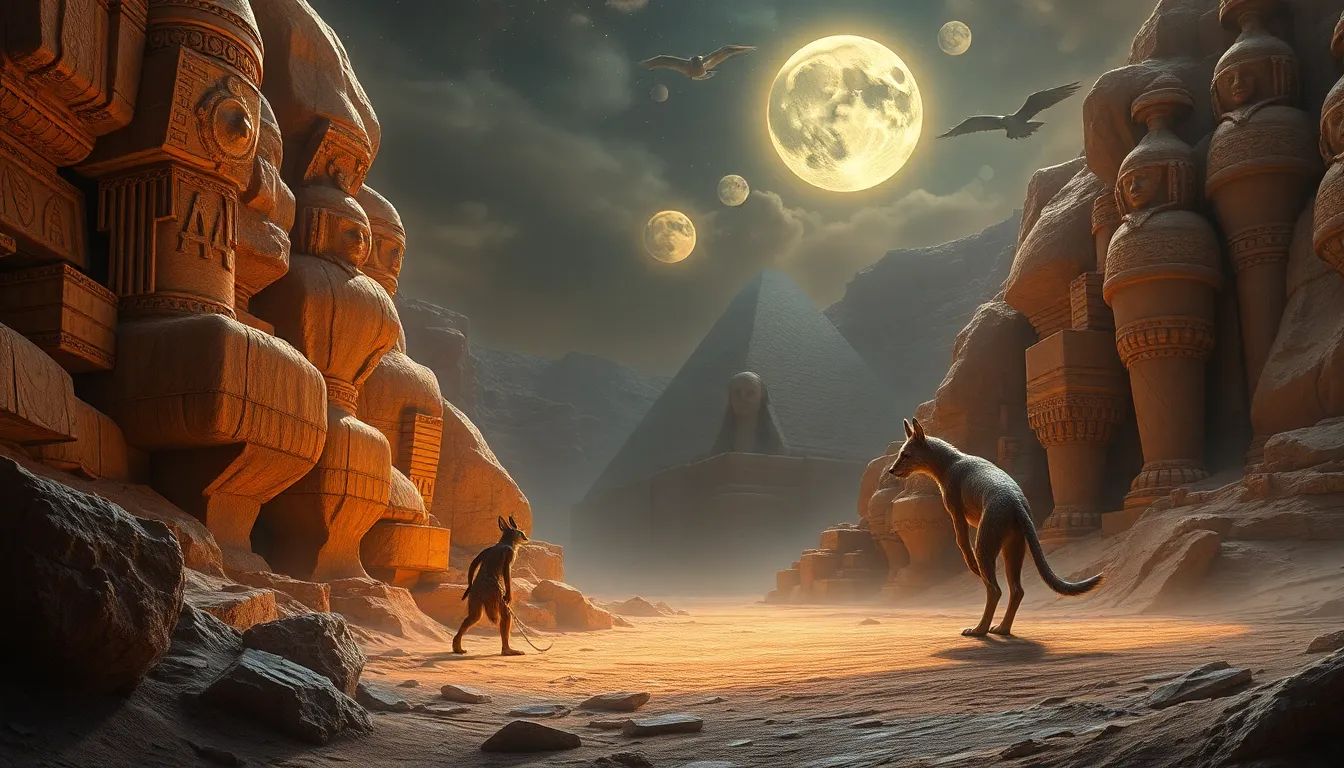The Geography of the Sacred Jackal: Myths of Anubis
I. Introduction
Anubis, the ancient Egyptian god of the afterlife, is often depicted as a jackal or a man with a jackal’s head. His figure played a crucial role in the funerary practices and beliefs of ancient Egyptians, who revered him as the protector of the dead and the guardian of the underworld.
The jackal, a scavenger often associated with burial sites, held significant meaning in ancient Egyptian culture. This article explores both the geographical and mythological aspects of Anubis, revealing how his symbolism transcended mere representation and became intertwined with the landscapes of ancient Egypt.
II. Historical Context of Anubis
Anubis emerged as a prominent deity during the early dynastic period of Egypt, evolving through various historical contexts. Initially, he was a god associated with the dead, but his role expanded as ancient Egyptian religion developed.
Throughout history, Anubis was integral to funerary practices. He was believed to oversee the mummification process and guide souls to the afterlife. His relationship with other deities, such as Osiris, the god of resurrection, solidified his importance in Egyptian cosmology.
III. Symbolism of the Jackal in Ancient Egypt
The jackal’s scavenging nature made it an apt symbol of death and the afterlife. Seen frequently around cemeteries, it was believed that jackals would protect the dead from desecration.
Cultural interpretations of the jackal varied across different regions of Egypt. For instance:
- In Upper Egypt, the jackal was often viewed as a guide in the afterlife.
- In Lower Egypt, it was seen more as a guardian of tombs.
Compared to other animals in Egyptian mythology, such as the falcon representing Horus, the jackal’s association with funerary rites gives it a unique place in the pantheon of Egyptian deities.
IV. Sacred Sites Associated with Anubis
Several key archaeological sites in Egypt are linked to the worship of Anubis, showcasing the geographical significance of his myth.
A. Key archaeological sites linked to Anubis worship
- The Necropolis of Saqqara: This vast burial ground features numerous tombs and pyramids, and it is here that Anubis was frequently invoked during the mummification processes.
- The Valley of the Kings: Another significant site where Anubis was honored, especially in the context of royal burials and the afterlife journey.
Artifacts and hieroglyphs depicting Anubis have been uncovered at these sites, providing insights into the ancient Egyptians’ reverence for this deity. Today, these locations continue to attract tourists and researchers alike, emphasizing their modern-day significance.
V. Myths and Legends of Anubis
Anubis is central to various myths and legends that often have geographical ties to ancient Egypt. One of the most notable is the story of Osiris, where Anubis plays a vital role in the resurrection of the slain god.
In the narrative, Anubis embalms Osiris, ensuring his safe passage to the afterlife. This myth not only illustrates Anubis’s protective nature but also highlights the close relationship between the gods and the geography of the Nile Valley, which was essential for sustenance and burial practices.
Moreover, Anubis is depicted as a protector of the dead in numerous tales from different regions, reinforcing his widespread worship and significance across Egypt.
VI. Anubis in Popular Culture
The figure of Anubis has transcended ancient mythology to become a prominent symbol in contemporary culture. His representation can be found in literature, film, and art, where he often embodies themes of death and the afterlife.
Some examples include:
- In modern literature, Anubis appears in series such as “The Kane Chronicles” by Rick Riordan.
- Films like “Gods of Egypt” feature Anubis as a character, showcasing his mythological importance.
Additionally, the reinterpretation of Anubis in various media often leads to discussions about cultural appropriation, as his image is sometimes used without a full understanding of its significance in ancient Egyptian belief systems.
VII. The Geographic Spread of Anubis Worship
The worship of Anubis was not confined to a single region but spread throughout ancient Egypt and into neighboring cultures. His influence can be seen in various religious practices and beliefs.
As Egypt engaged in trade and cultural exchange, aspects of Anubis’s worship made their way into the beliefs of surrounding peoples, blending with local deities and traditions.
However, as the ancient Egyptian religion began to decline, so did the formal worship of Anubis. Today, his legacy endures in modern interpretations and scholarly studies, reflecting a complex interplay between history and mythology.
VIII. Conclusion
In summary, Anubis serves as a crucial figure in understanding the geographical and mythological landscape of ancient Egypt. The sacred jackal’s significance in funerary practices, coupled with the geographical context of his worship, illustrates a rich tapestry of beliefs that have persisted through time.
Reflecting on Anubis’s enduring legacy, it is evident that the intersection of geography and mythology continues to inform our understanding of ancient cultures and their beliefs about life, death, and the afterlife.
Ultimately, Anubis remains an iconic symbol, representing not only the ancient Egyptians’ reverence for the dead but also the ongoing fascination with their rich mythology in contemporary society.




